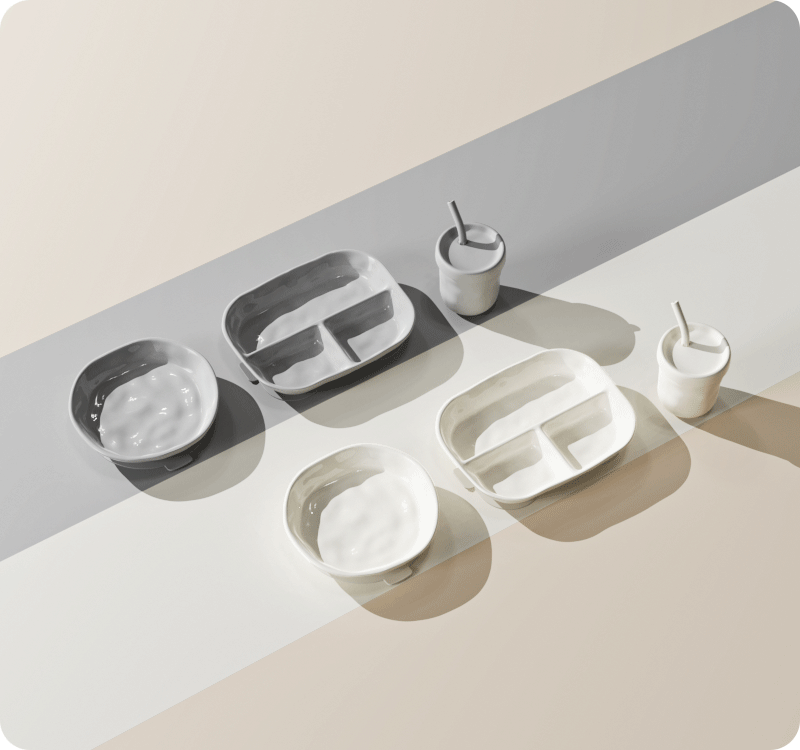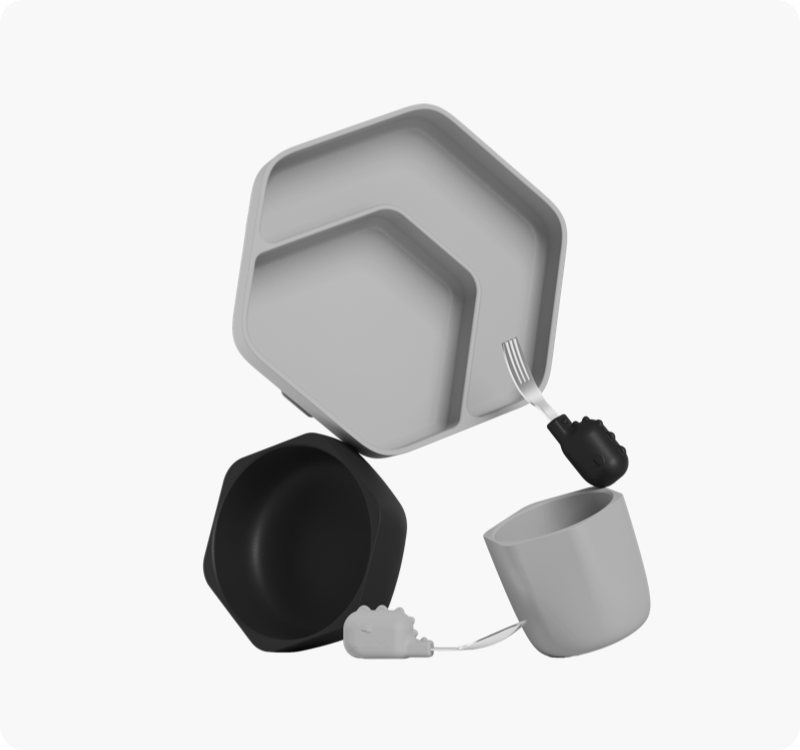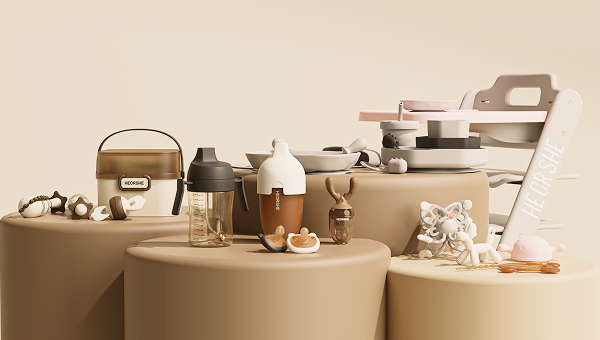Introduction
Feeding time is more than just a daily routine—it’s a developmental milestone for babies and toddlers. With the right tools, this stage can become a positive and empowering experience for both the child and the caregiver. Among the most recommended mealtime tools by pediatricians and parenting experts are the baby silicone feeding set and the children's spoon and fork set. These products are designed to support self-feeding, reduce mess, and ensure safety during those early bites.
In this comprehensive guide, we’ll explore the features, benefits, types, buying tips, and safety considerations of these essential feeding tools. Whether you're a first-time parent or a seasoned caregiver, you'll find valuable insights to help you choose the best products for your child’s feeding journey.

What Is a Baby Silicone Feeding Set?
A. Definition and Components
- A baby silicone feeding set typically includes a combination of the following:
- A suction bowl or plate
- A silicone bib with a food catcher
- A training cup or sippy cup
- A silicone spoon and fork
- A snack cup with a soft lid
These sets are made entirely of food-grade silicone—a non-toxic, BPA-free, and durable material that’s safe for infants and toddlers.
B. Why Silicone?
Silicone is widely favored for baby products due to its:
- High heat resistance: It can be microwaved or sterilized without releasing harmful chemicals.
- Flexibility and softness: Gentle on gums and teeth, ideal for teething babies.
- Non-porous surface: Resists bacteria buildup and stains.
- Eco-friendliness: Long-lasting and reusable, reducing plastic waste.
Using a baby silicone feeding set ensures that feeding time is hygienic, safe, and easy for both baby and parent.
Understanding the Children's Spoon and Fork Set
A. Introduction to Self-Feeding Tools
As children progress from being spoon-fed to feeding themselves, transitioning to a children’s spoon and fork set is key. These utensils are ergonomically designed for small hands and developing motor skills, helping toddlers gain independence.
B. Typical Features
- Rounded tips: Gentle on delicate gums and mouths.
- Choke guard or stopper: Prevents the utensil from going too far into the mouth.
- Textured handles: Improve grip and control, preventing slips.
- Colorful designs: Attract the child’s attention and make mealtime more enjoyable.
C. Materials Used
While plastic, stainless steel, and bamboo are also used, silicone is becoming a top choice for its flexibility, hygiene, and softness—especially in combination with a baby silicone feeding set. Parents often prefer all-silicone sets for their safety and durability.
Developmental Benefits of Feeding Sets
A. Motor Skill Development
Using a children’s spoon and fork set helps toddlers develop essential motor skills. Gripping, scooping, and bringing food to the mouth strengthens hand muscles and coordination.
B. Encouraging Independence
A baby silicone feeding set is designed to empower babies to start feeding themselves. Suction plates and bowls prevent slipping, giving the child more control and confidence.
C. Reducing Mealtime Stress
Features like spill-proof cups and suction bases mean fewer messes and cleanups. This reduces stress for caregivers and keeps the child focused on learning how to eat independently.
D. Promoting Healthy Eating Habits
Visually appealing, well-divided plates encourage healthy portion sizes and variety in food choices, laying the foundation for good nutritional habits.
![]()
Types of Baby Silicone Feeding Sets
A. Basic Starter Sets
Designed for babies who are just beginning solids (around 6 months old), these sets often include:
- A silicone bib
- A soft-tipped spoon
- A shallow suction bowl
These components are perfect for introducing solid foods safely and comfortably.
B. Full Feeding Sets
These sets cater to toddlers and include:
- Divided suction plate
- Deep suction bowl
- Matching spoon and fork
- Bib with deep pocket
- Snack container
- Training cup with handles
This type of baby silicone feeding set is ideal for regular, everyday use.
C. Travel Sets
Compact and portable, travel sets may include:
- Foldable or stackable containers
- Cutlery with travel cases
- Spill-proof snack cups
Great for outings, daycare, or visiting grandparents.
Choosing the Right Set for Your Baby
A. Age-Appropriateness
- 6–12 months: Look for soft, flexible utensils and small bowls.
- 12–24 months: Consider divided plates and easy-grip cutlery.
- 2+ years: Full feeding sets and advanced children’s spoon and fork sets can be introduced.
B. Safety Certifications
- Choose products labeled:
- FDA-approved
- Free of BPA, PVC, lead, and phthalates
- Tested for small parts and choking hazards
C. Ease of Cleaning
Busy parents need dishwasher-safe products. Look for smooth, one-piece designs that don't trap food particles.
D. Design and Functionality
Features to prioritize:
- Strong suction base
- Stackable and space-saving design
- Bright, engaging colors
- Microwave and freezer-safe options
How to Introduce Feeding Tools to Your Baby
A. Start with Soft Spoons
Begin by offering a silicone spoon with pureed foods. Let your baby hold and explore the utensil.
B. Demonstrate Use
Babies learn by observing. Eat together and show how to scoop food and bring it to your mouth.
C. Encourage Exploration
Allow your child to play with the baby silicone feeding set and children’s spoon and fork set outside of mealtime. This builds familiarity.
D. Maintain Consistency
Use the same set regularly to establish routine and confidence. Routine builds mastery.
Cleaning and Maintenance Tips
A. General Guidelines
- Rinse immediately after use.
- Use mild soap and warm water.
- Air-dry completely before storing.
B. Dishwasher Safety
Most silicone feeding sets are top-rack dishwasher safe. Avoid high heat drying cycles to prolong the lifespan.
C. Sterilization
Boil or steam sterilize parts that babies mouth regularly, especially for babies under 1 year.
D. Storage
Use drawer organizers or stackable bins. Keep parts of the baby silicone feeding set together for convenience.

Conclusion
Feeding is one of the most important bonding and developmental experiences during early childhood. A high-quality baby silicone feeding set paired with a well-designed children’s spoon and fork set can make mealtime easier, safer, and more enjoyable for both babies and parents.
From promoting fine motor development to minimizing mess, the benefits of these tools go beyond mere convenience. As you explore your options, prioritize safety, functionality, and eco-friendliness. Whether at home or on the go, the right feeding gear can transform feeding time into a joyful part of your daily routine.
FAQs
Q1: How do I clean a baby silicone feeding set?
A: Most silicone sets are dishwasher safe. Rinse immediately after use and sanitize regularly by boiling or steam sterilizing.
Q2: When should I introduce a children’s spoon and fork set?
A: Between 6–9 months is ideal, especially as your baby starts showing interest in self-feeding.
Q3: Are baby silicone feeding sets microwave safe?
A: Yes, most food-grade silicone products can safely be used in the microwave, but always check manufacturer guidelines.
Q4: How do I encourage my baby to use utensils?
A: Lead by example, offer practice during meals, and choose ergonomically designed children’s spoon and fork sets.
Q5: Can I use the same feeding set for multiple children?
A: Yes, if maintained properly. Silicone feeding sets are durable, hygienic, and resistant to bacterial buildup.


